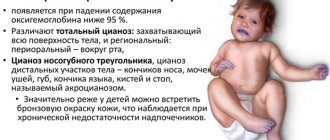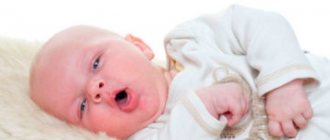A large number of people complain of a cold nose. This symptom has many causes and in most cases represents a functional reaction to low ambient temperature, but in some cases it can be a symptom of a pathological condition.
The issue of studying the etiology of this phenomenon in different age groups remains relevant, since a cold nose in a baby often alarms parents and requires additional diagnostics.
Cold nose in baby
Fluctuations in both local and systemic temperatures in newborns within acceptable limits do not indicate pathology, since the child is just learning to adapt to temperature, which differs from intrauterine temperature.
Causes of a cold nose in a newborn:
- Anatomical and physiological features of the structure.
A cold nose in a newborn is a consequence of the anatomical and physiological structure of the vascular system. The vessels of a newborn have a thinner wall and a loose connection with surrounding structures, which is the reason for the rapid narrowing of blood vessels in the cold.
- Maturity of the adaptive capabilities of the thermoregulatory system of the child’s body.
If a small child’s nose becomes cold while walking, this is evidence that the thermoregulation system is functioning very well. Vasoconstriction in the cold is a physiological phenomenon. This is how it should happen normally. If the cause of this symptom is the good development of adaptive capabilities, then it should not be eliminated under any circumstances.
- Insufficient blood supply to the child's nose.
Especially important!
If a child has a cold and pale nose while walking, this is normal. But if the nose gradually becomes cyanotic (blue), then this indicates that the child is cold and the walk should be stopped .
Cold nose in a newborn at home
You should be alert if your child has a cold nose at home at room temperature . On the one hand, this may indicate an approaching cold.
But if the child’s nose is cold almost all the time, and no symptoms of a respiratory disease are observed, then this should alert parents, since the cause may be congenital or acquired hemodynamic insufficiency.
A cold nose in a baby at home requires a visit to a cardiologist
It is recommended that such a child be examined by a pediatric cardiologist. A cold nose in this case may indicate insufficient blood supply not only to the nose, but also to a violation of systemic hemodynamics.
Also, a warm nose should be alert in cold air. If the child is of an early age, or was born prematurely, then the reason may be the immaturity of the child’s adaptive capabilities. In such cases, pediatricians do not recommend long walks outside during the cold season.
Experts' comments
- If it is difficult for a baby to sleep at night because of a stuffy nose, but there is no snot, then it may be that a large amount of mucus has accumulated in the larynx and when the child is in a horizontal position, it simply cannot flow out.
- If your nose is clogged, but it’s not a runny nose, you need to pay attention to the level of humidity in the room. It is this factor that very often turns out to be the cause of such negative phenomena.
- It is very important to engage in prevention; in this regard, the best option is frequent walks in the fresh air; if this does not help, then you should, of course, consult a doctor.
It is very important to understand that if such negative phenomena are long-lasting, then you need to promptly contact a specialist. Ignoring such phenomena can cause the most negative consequences, for example, the middle ear can become inflamed, which is then difficult and long to treat
So the cause of a stuffy nose can be anything, not just a runny nose. You need to be careful with children, they still don’t understand a lot. If children sleep soundly, then everything is in order in the nasal passage, the condition of the baby’s nose is excellent, and he fell asleep so that the next day he can enjoy life again.
Recommendations for parents when a baby has a cold nose
In order to prevent irreversible changes in the child’s hemodynamics, the cause should be eliminated and the following recommendations should be followed:
- Before a cold walk, dress your child in accordance with the outside temperature.
- Monitor the daily temperature of the child’s nose outside and in the house.
- Seek advice from a pediatric cardiologist in the case of: a warm nose at low ambient temperatures, a cold nose at room temperature.
The nose becomes cold when the external temperature is low, as a result of the blood vessels constricting in the cold.
Especially important!
Fluctuations in the temperature of the spout are normal for a newborn, as well as for premature babies up to 3-5 months, because the reason is the immaturity of the vascular wall.
Causes of a cold nose in a person
What does a person's cold nose mean? The symptom of a cold nose in a person has many causes. Some of them should be alarming, while others do not require further diagnosis and treatment. In order to choose tactics for further action, it is necessary to establish the cause of this phenomenon.
Why does a person have a cold nose?
- A cold nose due to freezing is the most common cause of this symptom. This reaction is natural. Reduced blood flow causes the skin to become more sensitive to low temperatures.
In this case, the symptoms of a cold nose are often combined with rhinorrhea (nasal mucus secretion). After returning to an environment with room temperature, the nose becomes warm again. This phenomenon is functional and does not require diagnosis or treatment.
- A cold nose is common in people whose sympathetic nervous system tone predominates over the parasympathetic nervous system.
Hypertonicity of the sympathetic nervous system is a very common cause of a cold nose. This type of person is characterized by a cold nose and extremities in most cases. This feature does not bring much discomfort and is not accompanied by changes in general hemodynamics.
Principles of neonatal treatment
Few parents understand that the nasopharynx of a newborn is not structured exactly the same as that of an adult. The respiratory tract of babies is very narrow, so even the slightest increase in the secretory function of single-celled glands in the mucous membrane leads to nasal congestion. In most cases, mothers try to cope with the “grunting” of the nose with the help of vasoconstrictor drops. However, conventional drugs often cause allergic reactions in children and even greater swelling of the nasopharynx.
Cleansing the mucous membrane of secretions
The first thing to do when a baby has a stuffy nose is to reduce the viscosity of the mucus. The watery secretion is quite easily evacuated from the airways, making breathing easier. To clear the nasopharynx of secretions, Komarovsky advises doing the following:
- lay the newborn on his back, placing a small pillowcase or towel under his head;
- drip 3-4 drops of “sodium chloride” into your nose (you can prepare a saline solution yourself by dissolving 1 teaspoon of salt in 1 liter of boiled hot water);
- take the child in your arms so that he is held upright;
- insert the tip of the aspirator into the nostril and suck out the accumulated mucus.
Important! Do not instill oil-based drops to thin mucus.
Oily nasal preparations such as Pinosol, Eucasept and Pinovit cannot be used to treat infants. Due to the narrowness of the nasal passages, they stagnate in the nasopharynx, which only worsens the well-being of the newborn.
Use of vasoconstrictor drops
As already mentioned, conventional vasoconstrictor drugs cannot be instilled into newborns. They contain too many active ingredients that can cause adverse reactions - nausea, vomiting, diarrhea, etc. If impaired nasal breathing is associated with inflammation of the ENT organs, gentle children's medications will help eliminate the swelling:
- "Nazol Baby";
- "Nazivin";
- "Otrivin Baby."
They can be used only as a last resort and only as prescribed by a pediatrician. It is important to remember that infants breathe predominantly through the nose, so prolonged congestion can cause the development of serious complications.
Moisturizing the nose
If a child grunts through his nose, the cause may be crusts that form in the nasal canals. They are dried nasal mucus, which occurs due to insufficient hydration of the mucous membrane. Dry or dusty air in the room can provoke their appearance.
Moisturizing nasal drops will help restore normal breathing. With their help, you can not only prevent drying out of the mucous membrane, but also soften and painlessly remove crusts in the nose. The following drugs can be used to treat the youngest patients:
- "Aqua Maris";
- "Humer";
- "Marimer";
- "Dolphin"
To increase local immunity in the ENT organs, it is recommended to instill Interferon into the nose. Nasal congestion in newborns goes away only if the viscosity of nasal secretions in the nasopharynx is relatively low.
To prevent mucus from thickening, E.O. Komarovsky recommends maintaining a fairly high air humidity in the room - at least 60%.
Why is there a cold nose in a warm room?
Impaired blood supply is the most unfavorable prognostic reason. If the skin is in a state of constant ischemia, then the nose is cold for a long period of time.
Diagnostic criteria for insufficient blood supply to the nose (ischemia):
- Cold nose almost all day long, even in a warm room.
- The nose becomes warm after intensive rubbing with the hand, but after a short period of time the low temperature is restored.
- The nose becomes cyanotic.
- A cold nose during ischemia is not accompanied by intense nasal discharge.
A cold nose as a result of ischemia may indicate circulatory failure in general.
If this symptom is combined with cold extremities, cold legs during sleep, general weakness, pathological sensations in the heart area, then this confirms the presence of insufficient blood supply and requires further diagnosis by a cardiologist with subsequent stabilization of systemic circulation.
The influence of toxic substances on the vascular wall of the nasal cavity is one of the reasons that contributes to the chronicity of the process.
Smoking, inhaling toxins, as well as working in hazardous enterprises leads to the fact that the vascular wall loses its former elasticity. Nicotine and other toxins constrict blood vessels, which leads to a regional decrease in the temperature of the olfactory organ.
Recommendations for systemic improvement of blood supply
Systemic improvement of blood supply leads to normalization of regional blood flow and an increase in local temperature in general.
In order to increase the intensity of blood circulation, it is recommended to eliminate the cause of the insufficiency and follow the proposed recommendations:
- Massage the lower extremities.
- Rubbing your feet with alcohol solutions will help improve blood circulation.
- Regular exercise or physical activity.
- Taking a warm bath will help dilate peripheral blood vessels.
- In order to normalize systemic hemodynamics, doctors recommend gradually hardening the body. After a cold douche or contrast shower, you should definitely warm up (warm drink, cover yourself with a blanket, continue physical activity).
Pediatrician's opinion
Having found out what a cold nose means in a baby, begin the necessary treatment. However, using drug therapy without consulting a doctor can be dangerous to the health of the newborn. Therefore, before the course of treatment, read the advice of Dr. Komarovsky.
Komarovsky is a pediatrician, a doctor of the highest degree.
According to Komarovsky, in order to prevent dysfunction of the blood supply, it is important to systematically improve regional blood flow. Increasing the intensity of blood circulation occurs in the following way:
- Massage your baby's arms and legs.
- Rub the child's limbs with alcohol lotions.
- Don't forget the importance of sports. Include light exercise in your daily to-do list.
- To dilate peripheral blood vessels, take warm baths.
Important
! You should not take hot baths, as they can disrupt the functioning of the baby’s blood vessels.
In addition, Komarovsky advises hardening a small organism.
To do this, bathe your child in a contrast shower every day, and then give the child warm milk or tea. After a shower, you should not walk around undressed or stand in a draft.
To strengthen the functioning of the cardiovascular system, according to the pediatrician, it is useful to walk in the fresh air. Long walks influence the formation of the immune system and provide the body with vitamin D.
Sun rays are necessary for the formation of vitamins.
In the cold season, the duration of walks should be reduced,
but you shouldn’t give them up at all. Infants under one month should not be outside when the temperature is below five degrees Celsius. Older children can walk down to minus ten degrees.
Child's clothes
Komarovsky reminds that a child should feel comfortable when walking
. This means you should not dress your baby warmer than necessary.
Important! If you notice that your child is getting wet and sweating, wear less clothing.
Walking in the rain is not prohibited, but do not forget about waterproof children's clothing.










